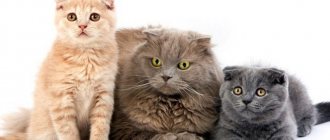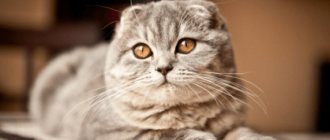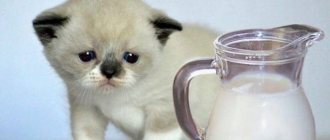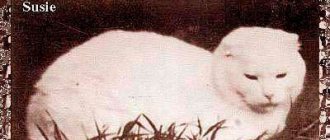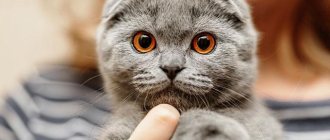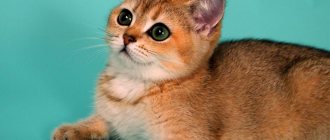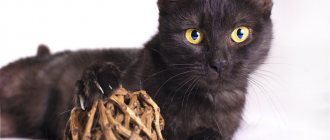- Cats
- General issues
Do you remember your tenderness when you first saw a light-colored cat “in dark socks”, with dark ears and a muzzle? And I immediately wanted to know what kind of cute creature this was. Today we will tell you about the breeds of these cats, how and when they were bred, their character and care for them.
Color point color and its features
The English phrase color point is translated as “color spot”. With this color, most of the body remains almost white, and certain areas (legs, tail, ears and muzzle) are covered with dark spots.
“
REFERENCE!
The severity of the transition between light and dark zones determines the value of the animal. The larger it is, the higher the final cost. Residual patterns and spots on the body are considered defective.
The following features are characteristic of color-point colors:
- Temperature dependence. When it gets colder, the amount of dark shade increases.
- Age-related changes in the intensity of points. Newborn color point kittens are completely white or light cream. This is due to the consistently warm temperature in the mother's womb. The first black markings appear within a couple of days after birth, and by 6-10 months the coloring is completely formed.
- Relationship with the color of the iris. It can be strictly blue, and the clarity of the points depends on its brightness.
The darkening of the fur coat under the influence of cold is easy to notice in cold weather. If a cat sleeps on a windowsill, then the part of its body leaning against the window will lose its whiteness.
color-point groups
The activity of the point color gene is activated when it is present in two sires. Scientific research has revealed that individuals of this color are partly albinos. At birth they have a snow-white coat color, which later turns into color point. In the first month of life, the ears darken, a month later - the nose, and then the entire muzzle. Dark spots should be intense, contrasting relative to the body.
Color changes when exposed to heat or cold. To maintain purity and uniformity of color, such animals require warm conditions.
Solid colors
Solid color point varieties are widespread among furry representatives of the British breed. Owners of the classic color point have a very light body framed by areas of the main color.
The fur is short, with a dense structure. The correct color is contrasting, the hairs in dark areas are evenly colored. The color of the point marks is clear, intense, no blurring, no dyed white hairs. The point markings, nose, and pads on the limbs are characterized by a single color.
Genetics issues
In genetics, everything is very strongly connected. Points in cats appear due to a special pigment - melanin, and this, in turn, due to the enzyme tyrosinase. The chain does not stop there either. At its base is the C gene. It is this gene that determines the final color of the hairs and iris.
The complete absence of pigment, characteristic of white coloring, occurs under the influence of the mutation gene c. Unlike its brother C, the c gene does not activate, but blocks the production of tyrosinase, which prevents color pigmentation and leads to the birth of an albino animal.
In addition to complete albinism, partial albinism is also possible. It is provided by the cs gene, which allows the pigment to penetrate into areas with the lowest temperature. This type of coloration is called acromelanism, or temperature-dependent.
“ INTERESTING!
The cs gene is recessive. It only works if both parents have it. The severity of the points is not important in this case. They may be hidden, but they still appear in at least some kittens.
Color Description
If translated from English, “color” means color, and “point” means a point. Points are small dark spots located on the face, tail, paws and ears.
The usual color of a cat is solid. The pigment is evenly distributed throughout the animal’s fur and body. Therefore, you can see the uniform color of the pet.
For a color point cat, everything is completely different. Their DNA contains the cs gene, thanks to which the pigment enters only the peripheral parts of the body, that is, the cold ones. They are located at a relative distance from the warm ones. Such areas are the ears, tail, paws and muzzle.
In other parts of the body, where the temperature is relatively higher, the pigment is not able to manifest itself actively. Scientifically this is called acromelanism .
Point color varieties
The color-point group includes several varieties. To classify them, the color of the points is used, as well as the presence of patterns, white spots and other interesting features.
Solid or solid
Solids are characterized by uniform coloration of points. Depending on the color of the pigment, the following subspecies are distinguished:
- seal point (classic Siamese) – dark gray, close to black;
- red point – red (red);
- blue point – blue (gray);
- cream point – light red;
- chocolate point – brown;
- tortoiseshell tortoiseshell;
- lilac point – gray-pink;
- cinnamon point – cinnamon;
- fawn point – light beige.
The color of the points matches the paws and nose. Interspersed stripes, spots and other patterns in this group are unacceptable.
Links
They are characterized by the presence of a tabby pattern (spots, stripes or marbles) on the ears, face, paws and tail. On the forehead of an animal with a link point there is always a mark in the form of the letter “M”, or the sign of a scarab.
The color of the markings is always darker than the points. The names of the colors in this group are generated by adding the prefix “tabby-”: seal tabby point, red tabby point – and so on.
Color point with white
It is an unusual combination of points and piebald coloration. In most cases, white spots appear on the face and front legs. They also cover half or a third of the body, merging with each other into a giant spot indistinguishable to the eye.
Silver
Characterized by zonal coloration of hairs. The base remains completely white and the top is dark. The group includes 3 subspecies, differing in the amount of white:
- smoky – ½;
- shaded, or shaded – ⅓;
- chinchilla – ⅛.
Another variety is distinguished separately - the silver tabby. It is a simultaneous combination of tabby (pattern) and silver (zonal coloring with a beautiful sheen).
Bicolors
Bicolor cats have a coat that combines white with other tones. In purebred animals, the pattern on the body is located symmetrically. Common bicolor varieties include spotted and striped.
Calico
The calico pattern is a combination of white with tortoiseshell or tabby. Among cat lovers, individuals whose fur resembles a Harlequin costume are highly valued - a predominance of white on the body in addition to black (the top of the head and ears).
Wang
The name van was given to individuals whose tail is a different color than the body. Sometimes there are colored markings on the head.
Cat breeds with color point colors
Thanks to the efforts of breeders, the list of color-point pets is gradually growing. Despite the diversity, only 5 breeds (Siamese, Thai, Himalayan, Balinese and Neva Masquerade) have colored points on the body - the only option recognized as a color standard.
Siamese
Notable for its graceful and elongated proportions, as well as large ears, pointed at the end. Disadvantages of the Siamese breed include kinks in the tail and squint.
Thai
“Thai” is a close relative of the “Siamese”, characterized by smoother and more rounded features. It was extremely popular in the USSR, where it was mistakenly called “Siamese”. The breed standard is under revision, therefore, in addition to purebred individuals, all animals with a similar phenotype are allowed to breed.
Balinese
It is a semi-longhaired version of the Siamese. The Balinese coat has virtually no undercoat. Its spine fits tightly to the body and visually shortens the actual length. In the area of the tail, the long hair forms a luxurious “plume”.
Neva Masquerade
A subspecies of the fluffy “Siberian” with a characteristic Siamese coloring. The Neva Masquerade got its name due to the dark pattern on its face, reminiscent of a carnival mask.
Himalayan
It appeared as a result of crossing the “Persian” and the “Siamese” and is the first successful experiment in the artificial creation of color-point coloring. Depending on the plane of the muzzle, it is divided into two subspecies: the classic Persian with a short, slightly upturned nose - and the Pekingese, with a pronounced brachycephalic skull.
British
The British color-point cat was obtained shortly after the Himalayan, since the standard “British” was crossed with it. The breed standard does not allow white spots or any eye color other than blue.
Scottish
The Scottish color-point cat is the result of experimental crossing with the color-point “British” and “Himalayans”. Unlike their parents, representatives of this breed have more graceful proportions, a spherical head, large owl-like eyes and the absence of long hair.
Sphinxes
The most interesting group is that due to the complete or partial absence of fur, the point color appears directly on the skin. Includes all three recognized varieties: Canadian, Don and Petersburg (Peterbald).
Tortoise shell (tortoiseshell, tortie)
Many randomly mixed large spots of two different colors, well delimited from each other and distributed throughout the body. There should be no spots too large or too small in the color. The nose (as well as the paw pads) should match the color - one color or another, perhaps spotted. The eyes are copper or dark orange. Possible options:
· classic tortoiseshell (tortie): the coat color is red with black spots, and the red can be of various shades. “Flames” on the sides and back are desirable, the colors should be warm and radiant;
· blue tortie, also known as blue cream (blue tortie, blue cream): The color of the coat is light blue, evenly mixed with soft cream, evenly distributed throughout the body. Small cream spots are allowed if they fit into the overall picture. The nose is grey-blue, pink or grey-blue with pink spots. The paw pads are the same. Eye color is even copper or dark orange. Excessive large spotting, dark blue or red tones in color, and a striped pattern are considered a fault.
· chocolate tortoise: milk chocolate and cream clearly demarcated spots evenly distributed throughout the body. At the same time, the cream color comes in all sorts of shades. The colors should be warm, and a tan mark on the face is desirable. The nose is milky chocolate colored, pink or milky chocolate colored with pink spots. Paw pads range from cinnamon to chocolate, pink or chocolate with pink spots.
· lilac tortie: lilac or light gray with a slight pink sheen and light cream spots evenly distributed over the entire body. A tan mark on the face is desirable. The nose is lavender, pink or lavender pink with light pink spots. The paw pads are lavender, pink or lavender pink with light pink spots.
Does color affect the character of a pet?
The main representatives of the Siamese color are firmly entrenched in the image of caricatured villains with a vengeful character. Irresponsible breeders, as well as the largest company, Disney, are partly to blame for this.
In the pursuit of profit, two things were ignored for a long time when breeding Siamese: squint and innate aggression. Both were not typical for these cats, so such animals had to be sterilized and neutered. In addition, mating with other breeds was actively practiced, and the behavior of mestizos is always unpredictable.
“ In 1955, 5 years before the Siamese standard was approved, Disney released the full-length cartoon Lady and the Tramp. The main villains there were Si and Ama - two Siamese cats. Thanks to the popularity of the cartoon, their image is firmly embedded in the minds of most viewers.
In fact, Siamese are one of the most loyal and very intelligent mustachioed pets. When properly bred and raised, they grow into docile and gentle companions.
Thanks to numerous experiments, points in kittens ceased to be a rarity and began to appear not only in Siamese, but also in many other purebred “mustaches.” Despite the change in coat color, the character of these animals remained the same.
" IMPORTANT!
Coloring is not able to influence the behavior of the animal. It only changes his appearance, and can also affect his health.
Owner reviews
I could never imagine my life without some animals. I always considered everyone I had as part of the family. The cat was bought about 5 years ago. He was about a month old then. He didn’t even know how to feed himself or go to the toilet yet. Most likely, the seller needed to sell the cat as quickly as possible, so he lied a little about the baby’s readiness for independent life. In general, the kitten was named Bonya.
Color point cats are very cute and gentle kittens, and adult cats too. They are quite interesting to watch. They are funny, active and cheerful.
We bought a British Shorthair as an adult. At that time she was 10 months old. She is very clingy by nature and loves a lot of human attention. She herself jumps into her arms, but only in those cases when she exactly wants it. You can squeeze for hours, the cat is very patient.
We have a Sphynx Peterbald cat. They set up a special place for her to sleep, but she only sleeps there during the day. At night he always comes to my bed.
The character is quite capricious. She hates being alone. When this happens, he immediately starts screaming. You can't just pick it up and play. You'll have to wait until she wants to. If she doesn't like something, she may even throw herself. She was scratched and bitten several times.
Source
How to choose the right kitten
To avoid being deceived, it is advisable to buy a Himalayan kitten from trusted breeders or certified nurseries. Before concluding a transaction, you must make sure that you have a veterinary passport with vaccination marks and documents confirming your breed.
It is also advisable to pay attention to the behavior and living conditions of small Himalayans. Kittens should be inquisitive and playful. And the room where the Himalayans live should be warm, light and clean.
It is important that kittens do not have fleas, bald spots, scratching, unpleasant odor from the mouth and dirt under the tail. Healthy Himalayans should have a soft coat and clean eyes and ears.
Kitten care
Himalayan kittens from good nurseries go to new homes no earlier than they are 12 weeks old. By this point, they are already eating a variety of foods on their own, know how to use a litter box, and are accustomed to a scratching post. Therefore, the owners only need to wait until the little Himalayan gets comfortable in the new place and show him where he can eat and relieve himself.
Owners must take care of the kitten's safety in advance. To ensure that the Himalayan does not suffer from his own curiosity, large equipment and windows are covered from him, and household chemicals, small items, indoor plants and wires are also hidden.
To prevent the kitten from developing digestive problems amid the stress associated with the move, at first it is fed what it is accustomed to. New foods are introduced into the little Himalayan’s diet gradually to monitor the body’s reaction. The feeding schedule is based on the age of the kitten:
- up to 12 weeks – 5-6 times a day;
- 3-6 months – 4 times a day;
- 6-12 months – 3 times a day.
An adult Himalayan cat is switched to twice feeding.
